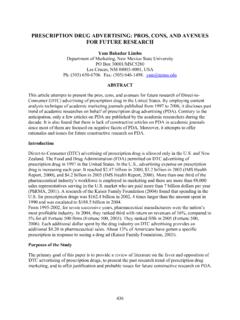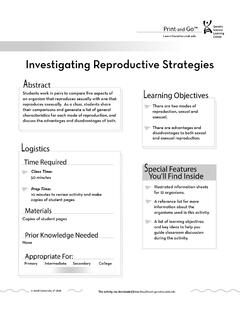Transcription of The Advantages and Disadvantages of the Virtual …
1 The Advantages and Disadvantages of the Virtual Classroom and the Role of the Teacher Authors: Guy Posey, Thomas Burgess, Marcus Eason, Yawna Jones Address Alabama A&M University, Box 429, Normal, AL 35762, Phone: Office: 256-372-4811 Cell: 601-520-1376 Email: ABSTRACT The Internet offers such Advantages as flexible access and new ways of communicating and assessing for students and teachers. The Internet also has some Disadvantages such as reliance of information service providers, credibility, viruses and in some cases, low speed of connections. However, for the teacher, creating Internet resources that are stimulating, appealing, effective, user friendly and educationally sound is time consuming. A new paradigm of education has developed, one that integrates the technology of computers and the Internet in education. With the introduction of sites such as YouTube and Facebook, we have many technological tools available to us.
2 The use of computers, and the Internet, opens a new world of potential. INTRODUCTION Following the emergence of the Internet in the early 1990s, many new tools and products have been developed to exploit its benefits fully. Since the mid-1990s the Virtual learning Environments (VLEs) have appeared with the aim of supporting learning and teaching activities across the Internet. Traditionally the school has been the place where teachers and pupils meet each other. It has been the setting where the institutional teaching/ learning process takes place. However, various forms of computer-mediated communication are adding interesting new dimensions to regular school learning . The Internet offers such Advantages as flexible access and new ways of communicating and assessing for students and teachers. The Internet also has some Disadvantages such as reliance of information service providers, viruses and low speed of connections.
3 However, for the teacher, creating Internet resources that are stimulating, appealing, easy to use and educationally sound is time consuming. The VLEs allow teachers to create resources quickly and without the need to develop technical skills. VLEs provide an integrated set of Internet tools, allow easy upload of materials and offer a consistent look and feel that can be customized by the user. PURPOSE Our society is changing. A new paradigm of education is developing, one that integrates the technology of computers and the Internet in education. We do not only learn from books. We have many technological tools available to us. The use of computers, and especially the Internet, opens a new world of potential. With the use of technology, education can surpass the physical boundaries of the classroom and provide students the opportunity to experience more.
4 Since Gutenburg, the Internet represents the largest transfer of information to occur in history. According to Robert B. Cummings, Director learning Resources Center, SHRP-SON at University of Alabama at Birmingham market research indicates that we can make the following assumptions: 50% of learning will continue to be "in person", involving things only available in person, although most of this activity will be facilitation 50% of learning will take place on the Internet, which is a better vehicle for cognitive learning due to the extent of information, low cost, and convenience Employers will expect to hire people who know how to learn on-line Education will become more student oriented (convenient), rather than faculty oriented Internet will dominate teleconferencing, because it's cheaper (lower technological investment) than video codecs, offers universal access, and has a high level of interactivity Personal computers will be ubiquitous The Internet is a huge resource, which is made more overwhelming by its disorganized state.
5 However, it offers so many significant learning opportunities which are delivered in a sensory way that is appealing and exciting to most students. Teachers who have delayed their training in this medium are now finding that their students have overtaken them in expertise and attitude toward the Internet from a very early age, and the teachers are finding it difficult to fit their own training and learning into an already busy time frame. One of the most important contributions of the Internet to teachers is the opportunity for global cooperation and International teaching and learning . By using the internet tools, students from different parts of the world, learning together, reading each other's ideas and views, discussing common concerns and understanding the differences in their attitudes. The purpose of this paper is to discuss the Advantages and Disadvantages of using computers and the Internet in education and also to discuss the role of teachers in Internet education.
6 PROBLEM Digital technology permeates the lives of students and teachers almost everywhere: school systems typically have at least one computer for every 15 students, teachers participate in on-line computer conferences with colleagues, schools are clamoring to be linked worldwide with the Internet, and video games and home computers are increasingly a routine part of students' experiences. A large percentage of teachers remain reluctant and skeptical about the Internet, with Becker in 2000 stating that up to 70% of American teachers fall into the reluctant or late adopter categories when it comes to new technologies. Less than 25% of all teachers have integrated technology-based tools into regular classroom programs. (Becker 2000) The same study by Becker showed that only 20% of teachers are at an advanced skill level to integrate technology use into the classroom.
7 Possible reasons for this giant chasm in technology skills amongst teachers: 1. Teachers have skills with people. In many cases computers do not interest people persons, as the interaction is predominantly one-sided. 2. Teachers need to know that the time they spend on learning a new skill will result in better student performance. They need to see value for time invested. (McKenzie 1999) 3. Most teachers are not pioneers in the computer field. They want products that are finished and have been tested, refined and perfected so they can see the finished product and then make a decision as to how it can be implemented into their program. 4. Teachers are busy people; they do not have time to mess around. (McKenzie 1999) 5. Teachers do not like surprises or disappointments in the classroom - when they have planned for something, it needs to be there.
8 Technology is still an unstable commodity. (McKenzie 1999) 6. The language of technology can be overwhelming and confusing to a non- user. (McKenzie 1999) 7. Lack of support within the school system prevents people from asking questions and moving forward beyond the survival or mastery stages. (McKenzie 1999) 8. Some Teachers are uncomfortable with the changing role of facilitating learning rather than directing or being in control. (McKenzie 1995) 9. Not knowing where to begin (Williams 1993) 10. Suspicion of technology or change. (Williams 1993) 11. Not knowing how to fix small glitches when they occur, hence do not like the possibility of this happening in the classroom and not knowing how to fix the problem. (Tipton et al 1998) 12. Reluctance to take the time to introduce an Internet based activity when there are so many other methods of instruction which are initially more efficient.
9 (Tipton et al 1998) 13. The risk that students may wander into inappropriate sites, and create a problem for the teacher. (Tipton et al1998) 14. Instructional goals, teacher experience, subject matter or curriculum area, available resources and support, and student needs are all factors that affect teacher's technology use. If they are in the mindset of incorporating technology when they plan a unit, it will not happen. ( Congress 1995) While computers are an important part of education, they cannot replace the natural world. Computer technology may enable us to see an example of how a stream's ecosystem works, but to get a full and authentic understanding, students must take a trip to a stream, and perform their own observations and tests. The hypothetical cyber-realistic demonstrates only a limited view of natural life. Advantages The use of the Internet in education is a topic that has received extensive attention.
10 There are some obvious Advantages when compared to traditional in-class education. The Advantages affect the students and teachers in different ways. The students are the people enrolled in the learning course. The teacher/instructor is the person who will be in charge of teaching the class. The teacher will send out materials, e-mail s, ect, instructing the students of what they need to be doing. The discussion that follows lists some of the Advantages that have been found in previous research. Several Advantages for using the Internet have been found. One significant advantage is that the Virtual classroom can help with instructor organization. Areas for course documents, assignments, class notes and other information can be readily categorized. The creation of a Virtual notebook can make locating documents easier for both instructor and student.



